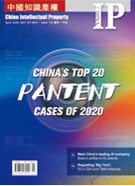Docket number of the case in the first instance: 184, first instance (初), administrative case (行), (2014) IP Court of Beijing No. 1 Intermediate People’s Court (一中知)
Docket number of the case in the second instance: 2935, second instance (终), intellectual property (知), administrative case (行), (2014) Beijing High People's Court (高)
Docket number of the case retried: 34, administrative retrial case (行再) , the Supreme People’s Court (最高法)
[Prefatory Syllabus]
When determining whether the specification is sufficiently disclosed, it shall be subject to the standard of the general technician in this area who not only has all the general technical knowledge in this area in which the invention is made before the application date or priority date, but also is capable of acquiring the prior art in this area. For non-distinguishing technical features, the specific implementation method of the specification may not be described in detail. To determine whether it is fully disclosed, it shall be subject to the fact whether relevant technical plans can be realized by the general technician based on the contents of the patent specification, the prior art in this area known to the general technician and the prior art in this area available to the general technician.
[Basic Facts]
Applicant of retrial (Third party in the case in the first instance): Shanghai Xiaoi Robot Technology Co., Ltd. (Hereinafter: Zhizhen Intelligent)
Respondent (Plaintiff in the case in the first instance and appellant in the case in the second instance): Apple Computer Trading (Shanghai) Co., Ltd. (Hereinafter: Apple)
Respondent (Defendant in the case in the first instance and appellant in the case in the second instance): China National Intellectual Property Administration
Zhizhen Intelligent is the obligee of the invention patent named "a chatbot system" (Hereinafter: the patent). The patent can allow the user to chat with the chatbot through the instant messaging or short message platform, and play interactive games with the robot using formatted command statements. Apple requested the court to invalidate this patent.
Both China National Intellectual Property Administration and the first-instance court held that, the technician in this area can realize the game features that utilize the chatbot system's game server for interaction in this patent based on his general technical knowledge, which meets the requirements of the Patent Law for full disclosure. Therefore, this patent remains in effect.
The second-instance court held, according to historical authorization archives of the patent, Zhizhen Intelligent recognized that the game server features are an important reason for the creativity of this patent. How the game server is connected with other parts of the chatbot is not recorded at all in the patent specification, and how to realize the game features limited by this patent is not fully disclosed. Therefore, the court ruled to annul the first-instance judgment and the sued administrative decision. Zhizhen Intelligent refused to accept the ruling, and applied to the Supreme People's Court for a retrial.
The Supreme People's Court held that, as the game server features in this patent are not distinguishing technical features between the patent and prior art, the technical plan involving the game server may not be described in detail. General technicians in this area can realize relevant technical contents according to the record in this patent specification. Therefore, the technical plan related to the game server in this patent meets the requirements of the Patent Law for full disclosure. After the trial, the Supreme People's Court annulled the second-instance judgment, and upheld the first-instance judgment.
[Typical Significance]
This case involves the basic patent in the area of computer artificial intelligence in China. “Disclosure for protection" is the basic principle of the patent system. To determine whether the technical plan that is applied for as a patent has been fully disclosed is not only a difficult issue for patent review and litigation in the AI area, but also directly decides whether the patent applicant has the exclusive right to the relevant technical plan. The retrial judgment clarifies the criteria for determining full disclosure of the patent specification related to computer programs, fully protects the independent innovation achievements of enterprises and helps strengthen the creation and reserve of independent intellectual property rights in key areas while ensuring public interest and encouraging innovation.




